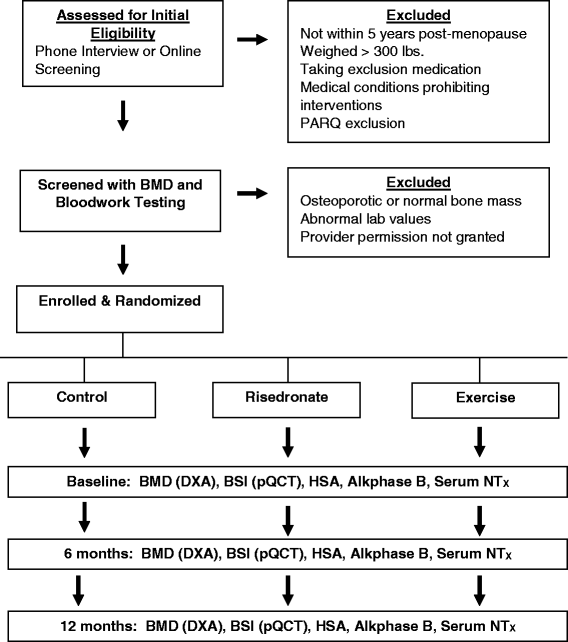Protocol for a randomized controlled trial to compare bone-loading exercises with risedronate for preventing bone loss in osteopenic postmenopausal women
- PMID: 27576310
- PMCID: PMC5004254
- DOI: 10.1186/s12905-016-0339-x
Protocol for a randomized controlled trial to compare bone-loading exercises with risedronate for preventing bone loss in osteopenic postmenopausal women
Abstract
Background: In the United States, over 34 million American post-menopausal women have low bone mass (osteopenia) which increases their risk of osteoporosis and fractures. Calcium, vitamin D and exercise are recommended for prevention of osteoporosis, and bisphosphonates (BPs) are prescribed in women with osteoporosis. BPs may also be prescribed for women with low bone mass, but are more controversial due to the potential for adverse effects with long-term use. A bone loading exercise program (high-impact weight bearing and resistance training) promotes bone strength by preserving bone mineral density (BMD), improving bone structure, and by promoting bone formation at sites of mechanical stress.
Methods/design: The sample for this study will be 309 women with low bone mass who are within 5 years post-menopause. Subjects are stratified by exercise history (≥2 high intensity exercise sessions per week; < 2 sessions per week) and randomized to a control or one of two treatment groups: 1) calcium + vitamin D (CaD) alone (Control); 2) a BP plus CaD (Risedronate); or 3) a bone loading exercise program plus CaD (Exercise). After 12 months of treatment, changes in bone structure, BMD, and bone turnover will be compared in the 3 groups. Primary outcomes for the study are bone structure measures (Bone Strength Index [BSI] at the tibia and Hip Structural Analysis [HSA] scores). Secondary outcomes are BMD at the hip and spine and serum biomarkers of bone formation (alkaline phosphase, AlkphaseB) and resorption (Serum N-terminal telopeptide, NTx). Our central hypothesis is that improvements in bone strength will be greater in subjects randomized to the Exercise group compared to subjects in either Control or Risedronate groups.
Discussion: Our research aims to decrease the risk of osteoporotic fractures by improving bone strength in women with low bone mass (pre-osteoporotic) during their first 5 years' post-menopause, a time of rapid and significant bone loss. Results of this study could be used in developing a clinical management pathway for women with low bone mass at their peak period of bone loss that would involve lifestyle modifications such as exercises prior to medications such as BPs.
Trial registration: Clinicaltrials.gov NCT02186600 . Initial registration: 7/7/2014.
Keywords: Bone mineral density; Bone structure; Bone-loading exercises; Calcium and vitamin D; Low bone mass; Osteoporosis; Postmenopausal women; Risedronate.
Similar articles
-
Bone-loading exercises versus risedronate for the prevention of osteoporosis in postmenopausal women with low bone mass: a randomized controlled trial.Osteoporos Int. 2022 Feb;33(2):475-486. doi: 10.1007/s00198-021-06083-2. Epub 2021 Sep 14. Osteoporos Int. 2022. PMID: 34519832 Clinical Trial.
-
The effect of weight training on bone mineral density and bone turnover in postmenopausal breast cancer survivors with bone loss: a 24-month randomized controlled trial.Osteoporos Int. 2010 Aug;21(8):1361-9. doi: 10.1007/s00198-009-1083-y. Epub 2009 Oct 3. Osteoporos Int. 2010. PMID: 19802506 Clinical Trial.
-
Twelve-month resistance and impact exercise program or risedronate provides a relative benefit to hip bone structure in postmenopausal women: results from a randomized controlled trial.Osteoporos Int. 2024 May;35(5):877-891. doi: 10.1007/s00198-023-07008-x. Epub 2024 Feb 17. Osteoporos Int. 2024. PMID: 38368307 Clinical Trial.
-
Bisphosphonates for prevention of postmenopausal osteoporosis.Dan Med Bull. 2002 Feb;49(1):1-18. Dan Med Bull. 2002. PMID: 11894721 Review.
-
Risedronate: a review of its pharmacological properties and clinical use in resorptive bone disease.Drugs. 2001;61(5):685-712. doi: 10.2165/00003495-200161050-00013. Drugs. 2001. PMID: 11368289 Review.
Cited by
-
Dietary Inflammatory Potential and Bone Outcomes in Midwestern Post-Menopausal Women.Nutrients. 2023 Oct 7;15(19):4277. doi: 10.3390/nu15194277. Nutrients. 2023. PMID: 37836561 Free PMC article. Clinical Trial.
-
Comparing the Effect of Bone-loading Exercises and Pulsed Electromagnetic Fields on Bone Turnover Markers in Women with Osteoporosis: A Randomized Clinical Trial Study Protocol.Arch Bone Jt Surg. 2024;12(7):522-530. doi: 10.22038/ABJS.2024.76983.3557. Arch Bone Jt Surg. 2024. PMID: 39070882 Free PMC article.
-
Effect of regular resistance exercise, vitamin D, and calcium supplements on the bone mineral content and density in postmenopausal model of rats: An experimental study.Int J Reprod Biomed. 2021 Jan 25;19(1):63-74. doi: 10.18502/ijrm.v19i1.8181. eCollection 2021 Jan. Int J Reprod Biomed. 2021. PMID: 33554004 Free PMC article.
-
Risedronate for the primary and secondary prevention of osteoporotic fractures in postmenopausal women.Cochrane Database Syst Rev. 2022 May 3;5(5):CD004523. doi: 10.1002/14651858.CD004523.pub4. Cochrane Database Syst Rev. 2022. PMID: 35502787 Free PMC article.
-
Approaches to Recruitment of Postmenopausal Women for a Community-Based Study.Nurs Res. 2019 Jul/Aug;68(4):307-316. doi: 10.1097/NNR.0000000000000356. Nurs Res. 2019. PMID: 30829836 Free PMC article.
References
MeSH terms
Substances
Associated data
Grants and funding
LinkOut - more resources
Full Text Sources
Other Literature Sources
Medical
Miscellaneous


